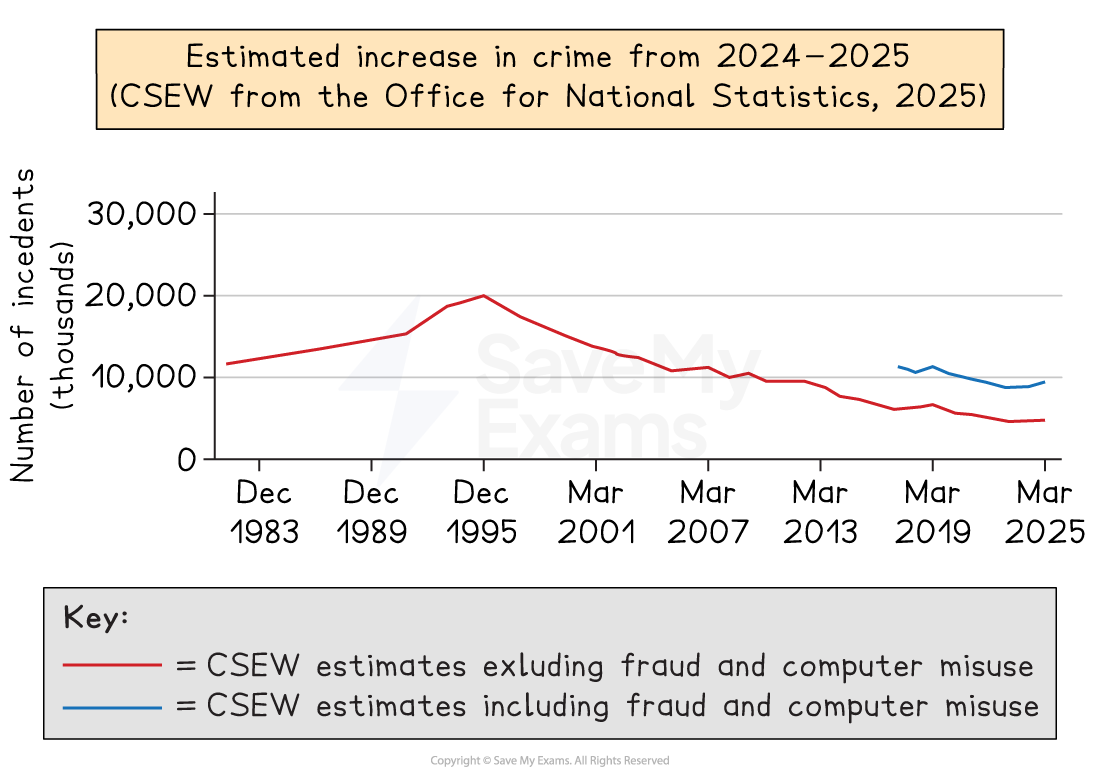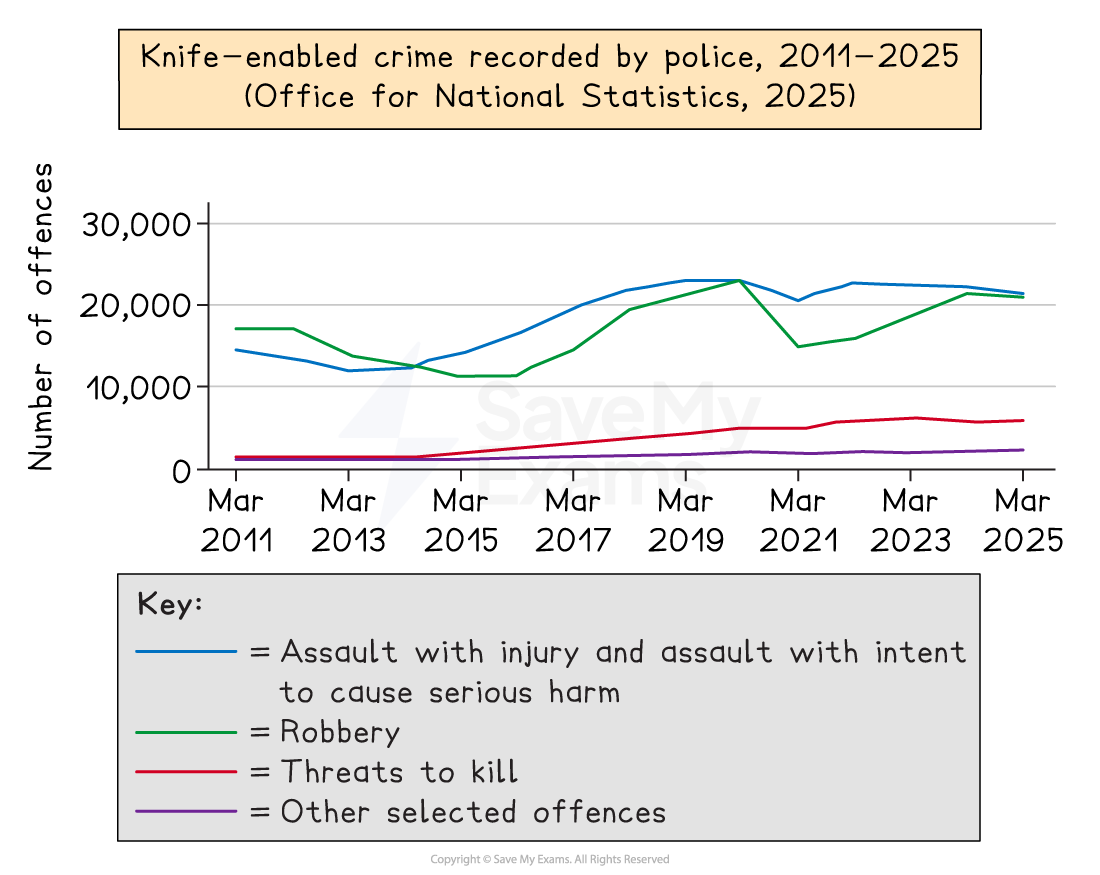Official Criminal Statistics (AQA A Level Sociology): Revision Note
Exam code: 7192
Statistics on crime
Most of what we know about crime comes from official criminal statistics (OCS), which are published quarterly by the government
Police-recorded crime – offences reported to and logged by the police
Crime Survey for England and Wales (CSEW) – a large-scale victimisation survey of around 47,000 randomly selected households
Captures crimes that may not be reported to the police
Participants aged 16 and over are asked about their experiences of different crimes in the 12 months prior to the interview
Crime patterns & trends
Official Criminal Statistics (OCS) are used to show trends and patterns in crime
They tell us about the:
volume of crime (how much there is and whether it is going up or down)
main types of crime being committed
social characteristics of people who are reported, arrested, or convicted
Volume of crime
The CSEW headline estimate of crime rose by 7% in the year ending March 2025, compared to March 2024 — from 8.8 million to 9.4 million incidents
This increase was mainly due to fraud (+31%), while computer misuse fell by 32% (ONS, 2025)
Police-recorded offences stayed almost the same: 6.6 million in March 2025 vs 6.7 million the year before (ONS, 2025)

Main types of crime
Crimes against people, e.g., violence, robbery, and sexual offences
Knife crime: police records show a slight fall in 2025, after increases in the late 2010s (ONS, 2025)
Crimes against property, e.g., theft, burglary, criminal damage
Property crime is much lower than in the mid-1990s: about 608,000 incidents in 2025 compared with 3.4 million in 1995 (ONS, 1995; 2025)

'Typical' social characteristics
This means the characteristics that are most often seen among people recorded in official statistics
It is important to remember these are patterns, not descriptions of every individual who commits a crime
Gender: In 2023/24, 84% of arrests were male and 16% female (ONS)
Men were around six times more likely to be arrested than women in 2022/23
Ethnicity: In 2022/23, Black people were 2.2 times more likely to be arrested than White people (20.4 vs 9.4 per 1,000)
Rates for Black men were 38.2 per 1,000 vs 16.0 for White men (ONS)
Age: Young adults are heavily represented in serious violence cases
Class and area: OCS suggest many offenders come from working-class backgrounds and urban areas
Differences in arrest and conviction rates by sex, ethnicity, and class do not simply reflect who commits a crime
The ONS warns that they are influenced by:
policing practices and priorities
where crime is concentrated
population structures (age, gender balance)
social and economic inequalities
Examiner Tips and Tricks
Be sensitive and precise when writing about the ‘typical’ social characteristics of offenders.
Official Criminal Statistics (OCS) highlight patterns, but these must be treated with caution. They reflect not only offending behaviour, but also how crime is reported by the public, recorded by the police, and influenced by policing priorities.
Problems with the recording of crime
Comparability issues
Changes in police recording practices and legal definitions make it difficult to compare crime over time
E.g., the counting rules for crime used by the police are subject to frequent change by the Home Office
E.g., in 2002, new offences such as stalking and hate crime were introduced, which suddenly increased recorded crime rates
Exclusion of certain crimes
Some crimes never appear in the OCS because they are handled by other agencies
E.g., white-collar and corporate crimes are not included in the OCS because they are dealt with by civil agencies such as HMRC and the HSE
Historical crimes
When old offences are pursued years later, they inflate the current figures
E.g., the crimes of Jimmy Savile were added to the 2014 statistics, even though they took place across 40 years.
Under-reporting
Many crimes are never reported to the police, especially those seen as too minor, embarrassing, or private
E.g., victims of domestic abuse may stay silent out of fear of reprisals or not being believed
Police discretion
Officers may decide not to record certain crimes, especially minor ones, to meet targets or save resources
E.g., bike theft might be downgraded or ignored as 'too trivial'
Victimless crimes
Offences with no direct victim only appear in statistics if actively targeted by the police
E.g., drug possession is usually only recorded when police carry out stop-and-search or raids
Political/organisational pressure
Forces may be influenced to record or present statistics in a way that meets targets or avoids criticism
E.g., crime league tables can encourage police to under-record offences to make detection rates look higher
Evaluating the usefulness of OCS
Strengths
Positivist acceptance of validity
Positivists regard OCS as a valid and realistic picture of crime in the UK
Functionalists and subcultural theorists have used OCS to explain why some social groups appear more criminal than others
Quantitative value
OCS provide regular, large-scale data, enabling analysis of long-term trends and patterns
They are valuable for designing crime prevention policies and targeting policing resources
Left realist perspective
Left realists argue that although OCS are socially constructed, they are still useful because they highlight real inequalities in victimisation
They point out that statistics show working-class people and ethnic minorities are more likely to be victims as well as offenders, which cannot be ignored
Criticisms
Interpretivists' challenge to validity
Interpretivists argue OCS reflect what the police and public choose to record/report, not the 'true' level of crime
They reveal police priorities and public attitudes more than actual offending behaviour
The role of victims
Many crimes go unrecorded because victims don’t report them (e.g., due to fear, embarrassment, or mistrust of the police), creating a 'dark figure' of crime
Victims from vulnerable groups (e.g., women in abusive relationships or some BAME communities) may be particularly unlikely to report crime
Labelling theory critique
Crime statistics are a social construction — they reflect the processes of labelling and selective law enforcement
Certain groups (young, working-class, and ethnic minorities) are stereotyped and policed more heavily, which inflates their representation in OCS
Marxist critique
OCS serve ruling-class interests by focusing attention on street crime committed by the working class
They divert attention away from white-collar and corporate crime, which causes significant harm but is less visible in statistics
Reliability problems
Changes in definitions, counting rules and recording practices (e.g., new offence categories) make comparisons over time unreliable
Sudden rises or falls may reflect administrative changes rather than real changes in crime
Examiner Tips and Tricks
Official Crime Statistics (OCS) are valuable for identifying patterns and trends in crime, but they are not a fully valid measure of crime. This is because they reflect reporting, recording, and policing practices as much as actual offending behaviour.
When writing about OCS, always link your evaluation to theories of crime and deviance:
Positivists see OCS as reliable and valid for identifying trends and patterns
Interpretivists and labelling theorists argue OCS are a social construction, shaped by police discretion and public reporting
Marxists claim OCS divert attention away from white-collar and corporate crime, focusing instead on working-class 'street crime'
Left realists accept OCS are flawed but stress they are still useful for showing real inequalities in victimisation.
Using this balanced approach demonstrates AO3 evaluation skills and will help you reach the top mark bands in your essays.

Unlock more, it's free!
Did this page help you?